#Ecosystem Stewardship
Text
Lismore Biodiversity News - Species Watch
During a recent field excursion, Environmental Strategies (ES) team members encountered a solitary Grey-Headed Flying Fox displaying concerning behaviours, including resting low in a tree away from its camp.
Supporting Grey-Headed Flying Foxes in Critical Times
During a recent field excursion, Environmental Strategies (ES) team members encountered a solitary Grey-Headed Flying Fox displaying concerning behaviours, including resting low in a tree away from its camp. Recognising these signs of potential illness, the team promptly contacted WIRES for guidance.
Such behaviours, including remaining in…

View On WordPress
#Australian Bat Lyssavirus#Bat-Friendly Practices#Community engagement#Conservation Education#Conservation Strategies#Ecosystem Stewardship#Environmental Awareness#Flying Fox Behavior#Grey-Headed Flying Fox#Habitat Preservation#Lismore Citiy Council#Lismore NSW#Native Nectar Sources#Rainforest Pollinators#Species Conservation#Starvation Prevention#Vulnerable Species#Wildlife Emergency Response#Wildlife Health#Wildlife Protection#Wildlife Rehabilitation#WIRES Hotline
0 notes
Text
The Importance of Outdoor Games For Youth
In the era of globalization and digital distractions, encouraging young people to engage in outdoor activities has become more crucial than ever. Beyond traditional exercises, outdoor games like basketball, archery, and baseball play a significant role in fostering physical, mental, and social development in the youth. There are 5 benefits of outdoor activities that can bring to young individuals overall well-being and growth.
1. Physical health: Outdoor games provide an opportunity for young people to be physically active and participate in activities that promote cardiovascular fitness, muscle strength, coordination, and overall physical health. Moreover, outdoor games offer a fun and exciting way for young people to stay active, making it more likely for them to maintain a healthy lifestyle throughout their lives.
2. Mental well-being: Spending time outdoors and participating in games can have a positive impact on mental health. It reduces stress, anxiety, and depression, and helps improve mood and self-esteem. The exposure to natural environments has been linked to increased feelings of happiness and relaxation. The open spaces and fresh air offer a therapeutic environment that aids in clearing the mind and reducing mental fatigue.
3. Cognitive development: Outdoor games often involve problem-solving, strategy, and critical thinking. Young people learn to navigate challenges, make decisions, and adapt their strategies in dynamic and changing environments. These experiences foster cognitive skills and enhance their learning abilities in the future. Such mental challenges help young people to making them more adept at tackling various academic and life challenges.
4. Social skills: Participating in outdoor games with peers helps young people develop important social skills, such as teamwork, communication, negotiation, and conflict resolution. They learn to interact with others, make friends, and collaborate effectively.These interactions are essential for developing social skills and building lasting friendships.
5. Reduced screen time: In today's digital age, young people may spend excessive time on screens (TV, computers, smartphones, etc.).Outdoor activities provide a healthy and enjoyable alternative, reducing sedentary behavior and its associated negative effects and this can have positive effects on their sleep patterns, mental health, and overall well-being.
In summary, outdoor activities and games are not only enjoyable but also essential for the holistic development of young people. By providing opportunities for physical exercise, these activities contribute significantly to their overall well-being, fostering a generation of healthier, happier, and well-adjusted individuals.

#unesco bmw#unesco#outdoors#exercise#mental health#ecosystem#ecosystem services#ecosystem stewardship#unesco body mind wellness club#unesco body mind wellness#Nur Wahida Pesol#nature#learn#Workshop#life style#better health#healthy life hacks#aspect of life#non profit#non profit organization#body and mind#empowerment#eco living#eco lifestyle#sustainability#global initiative#world#education#youth#adolescent
0 notes
Text
🌎 The Room to Roam Act: A Blueprint for Global Wildlife Protection 🌿

View On WordPress
#Assembly Bill 1889#Assemblymember Laura Friedman#biodiversity#biodiversity crisis#California Assembly#Climate Resilience#Community Empowerment#Community Engagement#conservation#conservation initiatives#Eco-friendly Infrastructure#ecological balance#ecological corridors#Ecological preservation#ecosystem connectivity#ecosystem conservation#ecosystem health#Ecosystem Preservation#Ecosystem Restoration#Endangered species protection#environmental advocacy#environmental awareness#environmental conservation#environmental impact#environmental justice#environmental legislation#environmental policy#Environmental Protection#environmental stewardship#environmental sustainability
0 notes
Text
someone tell me about the Elon musk wastewater thing in Texas like. I know it’s treated. it’s not that hard to use the nutrients where they need to nutrient (hydroponics hello or simply a biofiltration garden) and I’ve not seen the actual nutrient levels like there’s a chance it will be fine. there’s a chance they do not care. both could be true. but I need to actual science not hysteria when did environmentalism become this? I swear just give me the numbers I still remember toxicology from uni I will figure out if it is okay then design you a solution spaceX we can come up with something that works for all parties here
#I need to hire someone to do this research for me#water sensitive urban design#just can we stop xploiting our ecosystems or treating them like a political device please#decolonise. indigenise. land stewardship. is that so hard?
0 notes
Text
"In an unprecedented step to preserve and maintain the most carbon-rich elements of U.S. forests in an era of climate change, President Joe Biden’s administration last week proposed to end commercially driven logging of old-growth trees in National Forests.
Secretary of Agriculture Tom Vilsack, who oversees the U.S. Forest Service, issued a Notice of Intent to amend the land management plans of all 128 National Forests to prioritize old-growth conservation and recognize the oldest trees’ unique role in carbon storage.
It would be the first nationwide amendment to forest plans in the 118-year history of the Forest Service, where local rangers typically have the final word on how to balance forests’ role in watershed, wildlife and recreation with the agency’s mandate to maintain a “sustained yield” of timber.
“Old-growth forests are a vital part of our ecosystems and a special cultural resource,” Vilsack said in a statement accompanying the notice. “This clear direction will help our old-growth forests thrive across our shared landscape.”
But initial responses from both environmentalists and the logging industry suggest that the plan does not resolve the conflict between the Forest Service’s traditional role of administering the “products and services” of public lands—especially timber—and the challenges the agency now faces due to climate change. National Forests hold most of the nation’s mature and old-growth trees, and therefore, its greatest stores of forest carbon, but that resource is under growing pressure from wildfire, insects, disease and other impacts of warming.
Views could not be more polarized on how the National Forests should be managed in light of the growing risks.
National and local environmental advocates have been urging the Biden administration to adopt a new policy emphasizing preservation in National Forests, treating them as a strategic reserve of carbon. Although they praised the old-growth proposal as an “historic” step, they want to see protection extended to “mature” forests, those dominated by trees roughly 80 to 150 years old, which are a far larger portion of the National Forests. As old-growth trees are lost, which can happen rapidly due to megafires and other assaults, they argue that the Forest Service should be ensuring there are fully developed trees on the landscape to take their place...
The Biden administration’s new proposal seeks to take a middle ground, establishing protection for the oldest trees under its stewardship while allowing exceptions to reduce fuel hazards, protect public health and safety and other purposes. And the Forest Service is seeking public comment through Feb. 2 (Note: That's the official page for the proposed rule, but for some reason you can only submit comments through the forest service website - so do that here!) on the proposal as well as other steps needed to manage its lands to retain mature and old-growth forests over time, particularly in light of climate change.
If the Forest Service were to put in place nationwide protections for both mature and old-growth forests, it would close off most of the National Forests to logging. In an inventory concluded earlier this year in response to a Biden executive order, the Forest Service found that 24.7 million acres, or 17 percent, of its 144.3 million acres of forest are old-growth, while 68.1 million acres, or 47 percent, are mature."
-via Inside Climate News, December 20, 2023
-
Note: This proposed rule is current up for public comment! If you're in the US, you can go here to file an official comment telling the Biden administration how much you support this proposal - and that you think it should be extended to mature forests!
Official public comments really DO matter. You can leave a comment on this proposal here until February 2nd.
#united states#us politics#conservation#climate change#sustainability#forests#old growth forest#national forest#carbon emissions#climate action#climate crisis#forest service#biden#biden administration#public comment#good news#hope#it took me soooo long to hunt down the actual public comment link#by which I mean like 10 minutes but like#that's too long! especially considering I am way better at navigating language and bureaucratic websites like this#than A LOT of people#why tf can't you just comment on the Official Website For Public Commenting?#aka regulations.gov#baffling#anyway the good news is I did find it so pls do go ahead and submit a comment if you can
3K notes
·
View notes
Text
Here's a link you can hold onto in case you ever need to tell somebody why reintroducing predators into North American ecosystems is important
After decades of high deer populations, North American forests have lost much of their previous biodiversity. Any landscape-level recovery requires substantial reductions in deer herds, but modern societies and wildlife management agencies appear unable to devise appropriate solutions to this chronic ecological and human health crisis. We evaluated the effectiveness of fertility control and hunting in reducing deer impacts at Cornell University. We estimated spring deer populations and planted Quercus rubraseedlings to assess deer browse pressure, rodent attack, and other factors compromising seedling performance. Oak seedlings protected in cages grew well, but deer annually browsed ≥60% of unprotected seedlings. Despite female sterilization rates of >90%, the deer population remained stable. Neither sterilization nor recreational hunting reduced deer browse rates and neither appears able to achieve reductions in deer populations or their impacts. We eliminated deer sterilization and recreational hunting in a core management area in favor of allowing volunteer archers to shoot deer over bait, including at night. This resulted in a substantial reduction in the deer population and a linear decline in browse rates as a function of spring deer abundance. Public trust stewardship of North American landscapes will require a fundamental overhaul in deer management to provide for a brighter future, and oak seedlings may be a promising metric to assess success. These changes will require intense public debate and may require new approaches such as regulated commercial hunting, natural dispersal, or intentional release of important deer predators (e.g., wolves and mountain lions). Such drastic changes in deer management will be highly controversial, and at present, likely difficult to implement in North America. However, the future of our forest ecosystems and their associated biodiversity will depend on evidence to guide change in landscape management and stewardship.
The deer are literally eating all the tree saplings in a lot of areas so the forest is having the old trees die and no new trees grow, and they're eating all the rare wildflowers like orchids and trilliums.
Human hunting doesn't work, and sterilizing more than 90% of female deer doesn't work. The answers the researchers propose are regulated commercial hunting (basically, hunting deer in limited amounts so the meat can be sold just like farmed beef or pork) and reintroducing wolves and mountain lions.
"Wolves and mountain lions are dangerous!" Out of an estimated 458 deadly encounters with animals that occur in the U.S.A. yearly, an estimated 440 of them are fatal collisions with deer.
Next time there is some dumbass Republican trying to claim wolves don't need to be protected by the Endangered Species Act (yes, they're literally claiming that wolves are fully recovered when they don't even exist in the vast majority of their former range) have these links close at hand
863 notes
·
View notes
Text
Plastic Bank and Coca-Cola celebrates World Oceans Day
Plastic Bank and Coca-Cola Philippines celebrated World Oceans Day through Ecosystem Impact Week held in Robinsons Place General Trias. The Ecosystem Impact Week that was held from June 8 to June 12 highlighted the progress and milestones of Plastic Bank collection community members who continuously uphold their mission to stop ocean plastic. The event was made possible in partnership with…
View On WordPress
#coca cola#ecosystem impact week#environment conservation#ocean stewardship#plastic bank#press release#world oceans day
0 notes
Text

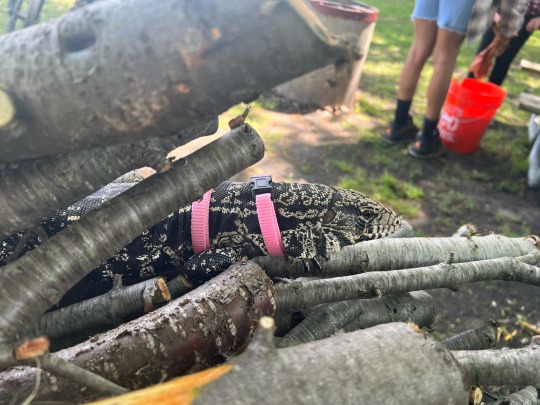
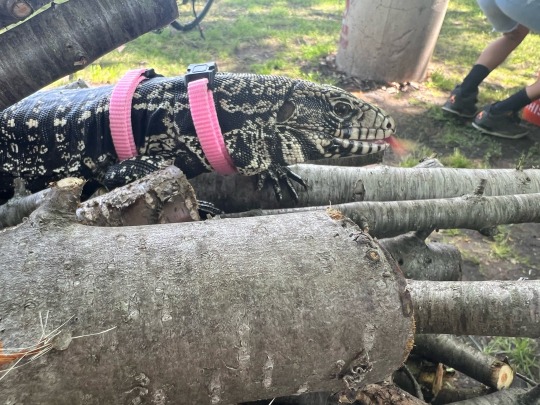
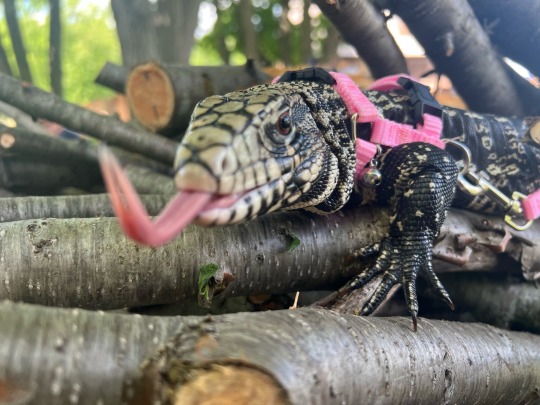
When I take Nakajima places as an educational animal, one of the big talking points is about how tegus are invasive, and what invasive species do to the environment. But not all invasive species are animals! This is common buckthorn, and it is one of the most invasive species in Illinois. Buckthorn grows almost anywhere and creates forest areas where nothing else can grow. It's so invasive that it's illegal for nurseries here to sell it.
A lot of times, we ignore the role of invasive plants. But they can wreak untold damage on delicate ecosystems, just like invasive animals. It's always a good idea to find out what is native in your area and support responsible land stewardship! Check with your local botanical gardens, parks, forest preserves, and other nature-focused organisations to find out what shouldn't be growing in your area and what you can do to help.
204 notes
·
View notes
Text


Fire suppression p.1 & p.2: “Flame Retardant” & “Building Potential” Inspired by the PEM's ‘Our Time on Earth’ exhibit
I was gladly surprised to see the exhibit’s various optimistic installations, especially the building materials of the future. As a forestry student I am beginning to understand our relationship to our forests differently. In the US, forest policy which aimed to suppress wildfires has contributed to a century-long build up of fuel that would otherwise have been cleared by controlled burns or small spontaneous ground fires. Indigenous peoples shaped the forests of the Americas to require these controlled burns. More and more I realize that indigenous knowledge and collaboration is a necessary part of the stewardship of future. A concept which is present at large at the museum but also specifically within Our Time on Earth. Getting a ‘sustainable’ amount of lumber from our forest still disregards the health and purpose of these trees to a diverse and complex ecosystem. It is essential that we diversify our building material, to include carbon-negative things like mycelium! Natural resources that are close by, and at hand in our local environment, which doesn’t require chopping down a tree 3000 miles away and transporting it to the US. We need local resources whose collective cultivation lead to a sense of community and collaboration. A better future!
My thanks to lane.m.artin for collaborating with me for p.2!
#acrylic painting#artists on tumblr#PEM#peabody essex museum#climate change#fire suppression#wild fire#TEK#Traditional ecological knowledge#controlled burning#art of mine#solarpunk#is how i would describe the exhibit but listen I am just doing my best and maybe this gallery might even see this piece in it's peripheral#and thats a win#contemporary art
122 notes
·
View notes
Text
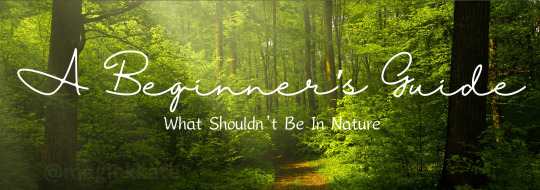
Hey beginner witches! When practicing your craft in nature, it's important to be mindful of the impact you have on the environment. Here are a few things to avoid leaving in nature:
Glass: Glass doesn't biodegrade and can pose a danger to wildlife if broken. Pack out any glass containers or bottles you bring with you and dispose of them properly.
Plastic: Plastic pollution is a major problem for the environment, so try to minimize your use of plastic and avoid leaving any plastic items behind in nature. Opt for reusable or biodegradable alternatives whenever possible.
Salt: While salt can be a useful tool in witchcraft, it's harmful to plants and can disrupt the delicate balance of ecosystems if scattered indiscriminately. Use salt sparingly and avoid leaving large amounts of it in natural areas.
Non-Biodegradable Offerings: Be mindful of the offerings you leave in nature and choose items that are biodegradable and won't harm wildlife. Avoid leaving behind items like plastic toys, balloons, or food wrappers.
Let's practice responsible stewardship of the earth and leave no trace of our magical workings behind. 🌿🚫🏞️
#witchblr#reference#witch#witchcraft#magickkate#queue the magick#kitchen witch#sigils#green witch#witchy#baby witch#baby witch tips#quarantine witch#cottage witch#college witch tips#witch aesthetic#college witch#witch community#beginner witch#witch tips#witchcraft 101#witchy vibes#witchyvibes#witches#witchtok#witchy shit#witches of tumblr#witchcraft community#witchcore#spell
80 notes
·
View notes
Text
This may be controversial, but Percy would not be a stay at home trophy husband. He would study oceanography at New Rome and then he'd work at an aquarium, probably with a focus on education and outreach. He'd be a docent, leading tour groups of school kids around and teaching them about the sea animals and ecosystems and environmental stewardship. And he and Annabeth would train demigods at Camp Half-blood during the summer.
#maybe he wouldn’t be famous like Annabeth is for her designs#but he’s not just a house husband#PJO#Percy Jackson and the Olympians#Percy Jackson#Annabeth Chase#percabeth
116 notes
·
View notes
Text
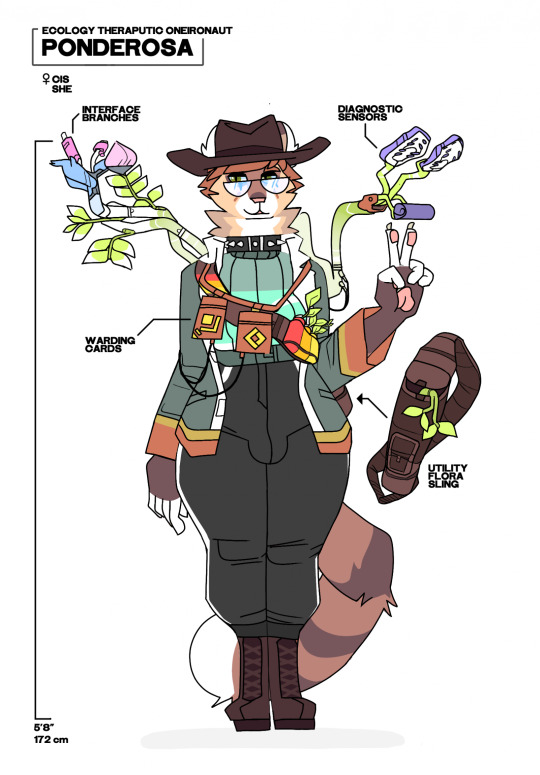
✨🤠🐱🌿🌌 tree healer, psychic cowgirl
in 5555 AD, the ecosystems of the human colonies have been totally transformed by cybernetics, fusing green and machine into new kinds of forest that communicate by wi-fi and chitter with artificial intelligence, wired to the grid. the mecha-forests are an invaluable boon to life in space, so governments commit millions of workers to their careful stewardship.
Ponderosa works for the forestry service along a section of the FTU's far-flung intercosmic highways; she is an experienced psychomedical technician, who dives into the cyberbrains of the forest to cure its dreams of infestation by dangerous memetic viruses.
#furry#cisgirl#scifi#science fantasy#cyberpunk#ecocybernetics#worldbuilding#standard candles#lavendart
175 notes
·
View notes
Text
Stand in solidarity with the Miccosukee:
Big Cypress Preserve is part of the Everglades, one of the largest remaining tracts of wetlands on Turtle Island (North America).
The Miccosukee Tribe have lived there since time immemorial and their care for their home has shaped it into the beautiful swamp we know today.
The National Parks Service is trying to rush a change in Big Cypress' designation from a Preserve to a Wilderness area. [plain text: The National Parks Service is trying to rush a change in Big Cypress' designation from a Preserve to a Wilderness area.]
This would give the area stronger protections for water quality, but would significantly limit the Tribe's access to their homelands and completely ignores how their stewardship of the lands and waters was and is crucial in maintaining the health of ecosystems.
There hasn't been a good faith effort to include the Miccosukee in a meaningful way (ie free informed prior consent & input!!!) on this change to their sovereign territory.
If you want to practice allyship, here's a chance. Sign the petition to show your support / solidarity with the Miccosukee. [plain text: Sign the petition to show your support / solidarity with the Miccosukee.]
Personalize it even just a little, even if it's just adding your own name or hometown. If you're able, print it out sign it and mail it. The Tribe and organizers working on this have a goal of getting 500 letters to the NPS/Secretary of the Interior. The online petition is almost at its goal! Just over 2,000 signatures left (as of Mar.16th 2024 21:30EST).
Please please share! I have it on good word that the NPS is trying to push this through before folks really have a chance to hear about what they're doing or make a fuss. So make a fuss we must.
The mailing addresses are below the cut for anyone who can send a physical letter!
Mail to:
Charles F. "Chuck" Sams III, Director
National Park Service
1849 C Street NW
Washington, DC 20240
Secretary Deb Haaland
Department of the Interior
1849 C Street, N.W.
Washington DC 20240
#landback#decolonization#indigenous rights#ways to help#how to be a better ally#accomplice activities#miccosukee#big cypress preserve#everglades#environmental activism#environmental justice#intersectionality#turtle island#plain text#water is life#us politics#i literally cant think of any other tags and idr how many tumblr actually tracks anymore lmao.#more info to come!! including possible ways to help the miccosukee ensure that this never happens again :)
67 notes
·
View notes
Text
Meet David Kirton during Arbor Week

View On WordPress
#adventure#afforestation#Arbor Week#awareness#biodiversity#Biodiversity Conservation#canopy growth#celebration#community#conservation#Conservation Efforts#Cultural Celebration#development#discovery#Ecosystem#ecosystem health#education#engagement#environmental advocacy#environmental awareness#environmental impact#Environmental Protection#environmental stewardship#Event#exploration#forest#forest management#future#George Genereux Urban REgional Park#green sanctuary
0 notes
Note
I'm guessing that as a graduate student you have read a zillion and one documents and books and papers and things in your field. Would it be outrageous to ask for recommendations/your favorites? I'm really interested in learning more about the history of Native land use and food systems in the midwest (which I suppose is a very long history, I'd be happy learning about any time period), prairie ecology, and the current outlook for native plants and pollinators (and conservation recommendations). Even one recc for each would be amazing. Feel free to postpone this ask if you're too busy! P.S. can't wait to read your dissertation.
This is a big ask, and I get a lot of these types of asks! In the future it'd be nice if people were more specific about their interests and not asking about general, huge topics. There's a level that you can and should be googling yourself! Many academic papers are online for free through sites like academia.edu and I'm not a search engine!
General answer if you're interested in this range of topics is Robin Wall Kimmerer's Braiding Sweetgrass. She comes from the midwest and writes some on prairie and the book is all about Indigenous science stewardship.
Otherwise, the topics you're asking for don't have one single source that will tell you everything you're looking for. People make small studies of one community, one ecosystem, one plant. Whether it's ecology or ethnobotany, there's no one making compendiums of info, especially not in the midwest. That's why I do the work I do, but even what I do is imperfect. Be suspicious of anyone who/any text that claims to be comprehensive on a huge, complex subjects; they probably are bsing you.
Indigenous Land Mgmt:
Two good recent papers:
The subject of indigenous wild management is more intensely covered in California (M. Kat Anderson) and Vancouver (Nancy J. Turner). Those two authors are great for both nuts and bolts chat and philosophical perspectives about how people have lived in and altered and restored their ecosystems.
A compelling academic book on the subject is Roots of Our Renewal:
Ethnobotany and Cherokee Environmental Governance by Clint Carroll, which is just as much about philosophy, knowledge production and protection and community building, as plants.
Prairie Conservation Practices:
Like I said above, currently published stuff is about very specific interactions and focuses, like a particular pollinator group in a particular plant. What you're looking for, a generalist summary of the field, doesn't really exist.
If you're looking for plant lists and how-tos Tallgrass Restoration Handbook or the Tallgrass Prairie Center Guide. Do not go for Ben Voigt. If you're looking for a general conceptual entry to Midwest conservation/restoration, there's Ecological Restoration in the Midwest
If you're looking for general recommendations for free, Xerces.org is the resource for bee-friendly landscaping and planting.
If you live near a University or Arboretum or Botanic Garden, this is the kind of thing where you should just browse the shelves near the books I've recommended! Chances are you have free access to the libraries, if not the ability to check the books out yourself!
#this is imperfect but it took 40 minutes just to put this together#please be considerate of people's time#long post
198 notes
·
View notes
Text
I think forgotten realms elves should be more embarrassed about Evermeet personally. Like you exploded the Weave and turned Faerun into continents to make your cool little god island, causing the deaths of thousands, the shattering of existing ecosystems due to things suddenly being Continents, and forced the world to change forever, how's that 'stewardship of nature and using magic responsibly' thing going for you. What makes you better than Netheril. Answer quickly
25 notes
·
View notes